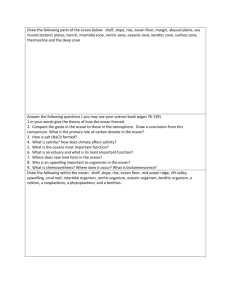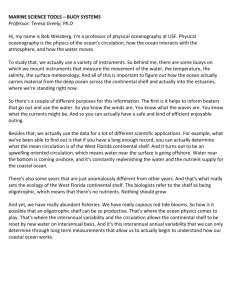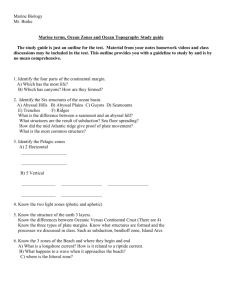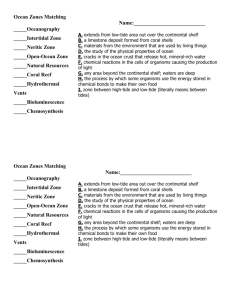Adaptation in Animals Project
advertisement
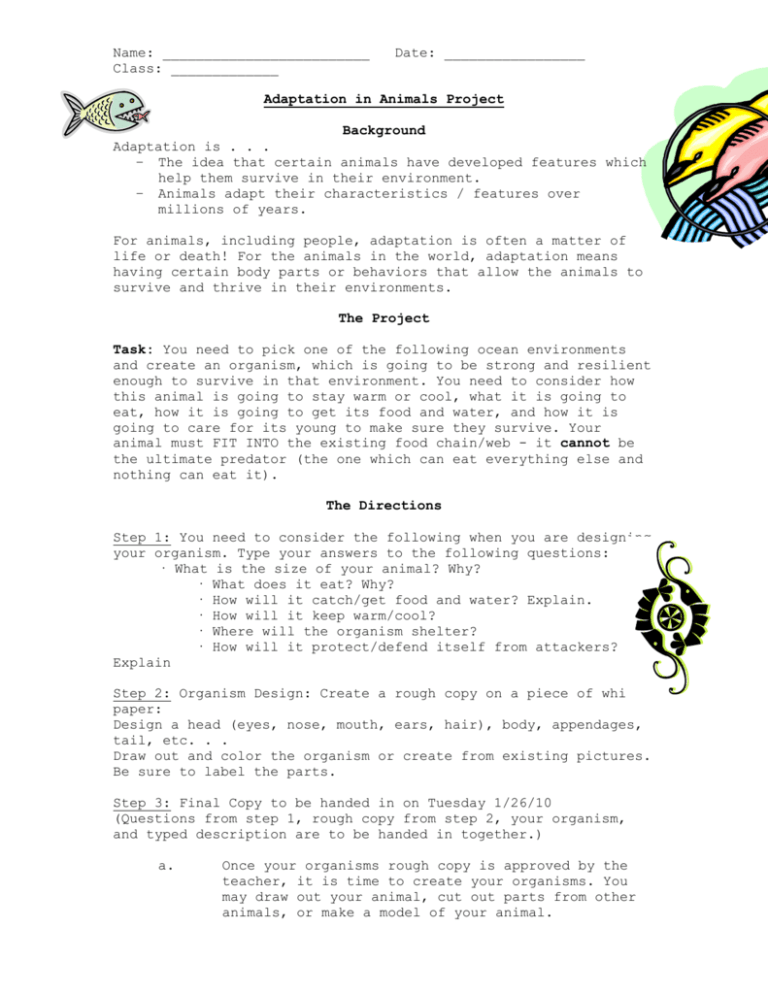
Name: _________________________ Class: _____________ Date: _________________ Adaptation in Animals Project Background Adaptation is . . . – The idea that certain animals have developed features which help them survive in their environment. – Animals adapt their characteristics / features over millions of years. For animals, including people, adaptation is often a matter of life or death! For the animals in the world, adaptation means having certain body parts or behaviors that allow the animals to survive and thrive in their environments. The Project Task: You need to pick one of the following ocean environments and create an organism, which is going to be strong and resilient enough to survive in that environment. You need to consider how this animal is going to stay warm or cool, what it is going to eat, how it is going to get its food and water, and how it is going to care for its young to make sure they survive. Your animal must FIT INTO the existing food chain/web - it cannot be the ultimate predator (the one which can eat everything else and nothing can eat it). The Directions Step 1: You need to consider the following when you are designing your organism. Type your answers to the following questions: · What is the size of your animal? Why? · What does it eat? Why? · How will it catch/get food and water? Explain. · How will it keep warm/cool? · Where will the organism shelter? · How will it protect/defend itself from attackers? Explain Step 2: Organism Design: Create a rough copy on a piece of white paper: Design a head (eyes, nose, mouth, ears, hair), body, appendages, tail, etc. . . Draw out and color the organism or create from existing pictures. Be sure to label the parts. Step 3: Final Copy to be handed in on Tuesday 1/26/10 (Questions from step 1, rough copy from step 2, your organism, and typed description are to be handed in together.) a. Once your organisms rough copy is approved by the teacher, it is time to create your organisms. You may draw out your animal, cut out parts from other animals, or make a model of your animal. b. Type up a full description of your animal which includes the following information: the organisms necessary resources; its niche; its specialized adaptations; how it is going to care for its young to make sure they survive? Which existing food chain does the animal fit into? And any other important information… Parts of the Ocean · Benthic Zone is the ocean bottom (ocean floor) This zone extends from the continental shelf to dark sparsely populated depths. Shallow lighted water extending over continental shelf contains 90% of marine species. · Pelagic Zone is the water in deep oceans (ocean waters) The main life factors · Three primary factors determine what kind of life lives in the ocean. They are sunlight, temperature, and pressure. · Based on these factors, the ocean is broken into three life zones called the Intertidal, Neritic, and Open Sea Zones. The Ocean Zones Intertidal Zone · This zone lies between the low and high tide lines. · Sometimes it is covered in water and sometimes it is dry. · Plants and animals that live in this zone have evolved special structures and techniques to survive in fast moving waters and changing tides. Neritic Zone · This zone extends from the low tide line to the edge of the continental shelf. It is usually only as deep as 200m. · This zone has the richest life because it has the best conditions for life. · Light is plentiful allowing plants to thrive. · The temperature is stable and the pressure is low. Open Ocean · All of the ocean beyond the continental shelf. It is so vast and deep that it is broken into 4 very broad zones: · The Sunlit Zone is the top layer in the ocean. It is named because there is plenty of sunlight. This is the layer where most ocean currents occur. This layer is from sea level to a depth of approximately 660 feet. · The Twilight Zone represents the maximum depth to which light penetrates water. Typically, no plants grow in this zone. This zone ranges from a depth of 660 to 3,300 feet. Temperature here may go down to about 41°F. · The Dark Zone ranges from a depth of 3,300 feet to about 13,200 feet. Water pressure increases tremendously and water temperatures range from 34-36°F. · The Abyss is without light and includes some of the deepest parts of the world’s oceans (more than 13,200 feet deep). Temperatures here are just above freezing and the animals that live in this region are some of the most unusual. Water pressure is tremendous, food is scarce and much of the seabed is covered with mudlike ooze.



